AFRICAN INFLUENCES IN PORTUGUESE CUISINE
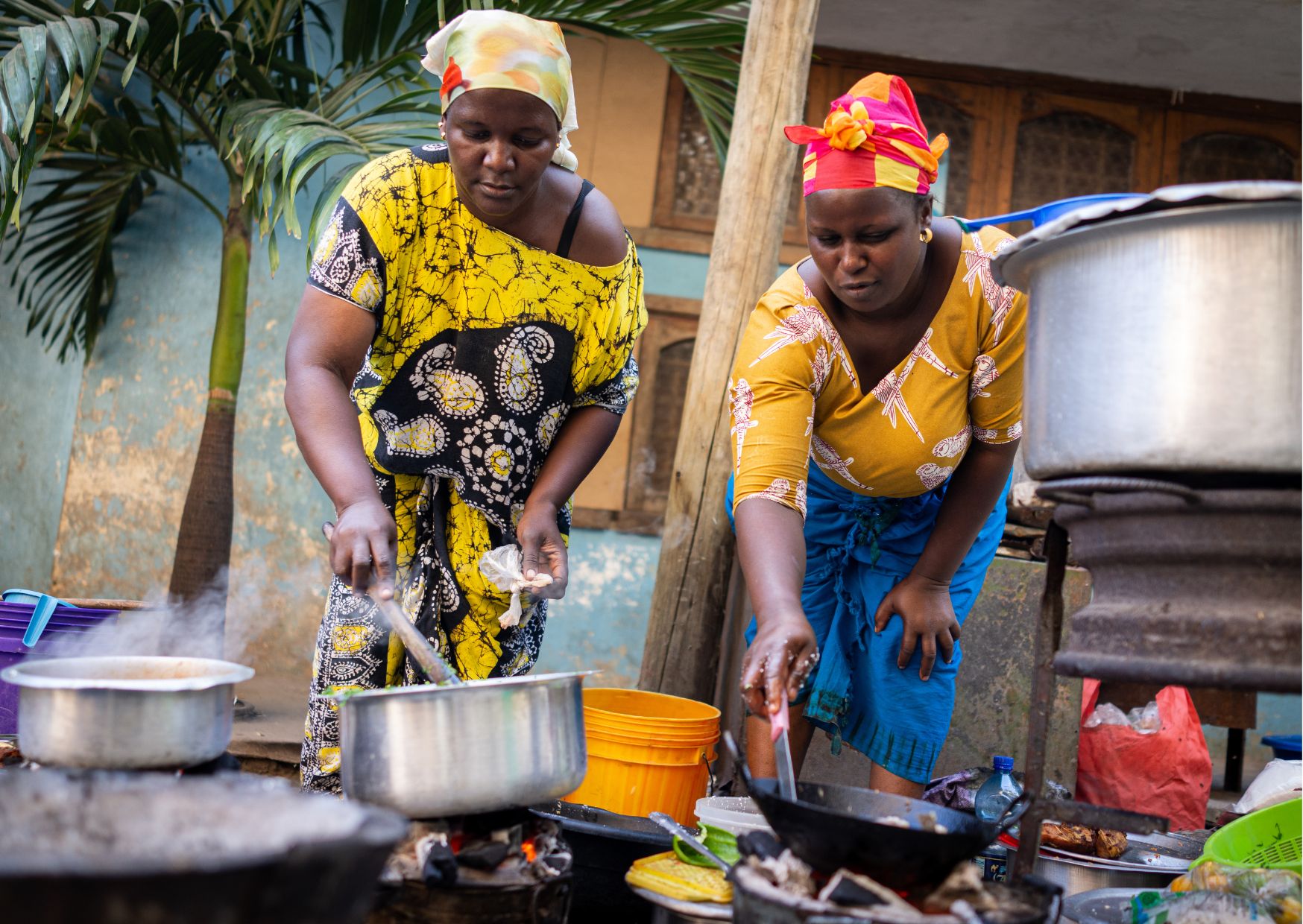
Food is a beautiful materialization of the interconnectedness amongst peoples from different geographical origins and cultures. Thanks to human movements across history – very often in hard conditions and, on other cases, forced -, as well as exchange of ideas even at a distance (particularly now-a-days thanks to technological advances like the internet), cuisines virtually know no borders.
Many of the ingredients and dishes we find in Portugal today tell the story of how the country has historically been linked with Africa and how this continent and its many cultures and traditions have influenced the way we live and eat.
What’s the connection between Portugal and the African continent?
When we say that Africa has influenced the way we eat in Portugal it is first and foremost relevant to stress that, in no way we mean to group all of Africa’s cultures and traditions under the same umbrella. We recognize that, thanks to its sheer dimensions and the diversity one can come across in the different African nations (now and throughout history), Africa certainly doesn’t have one unique identity. We are aware of that, and we shall explore how different African cultures have had an impact on Portugal and Portuguese food in different periods and with variable intensities.
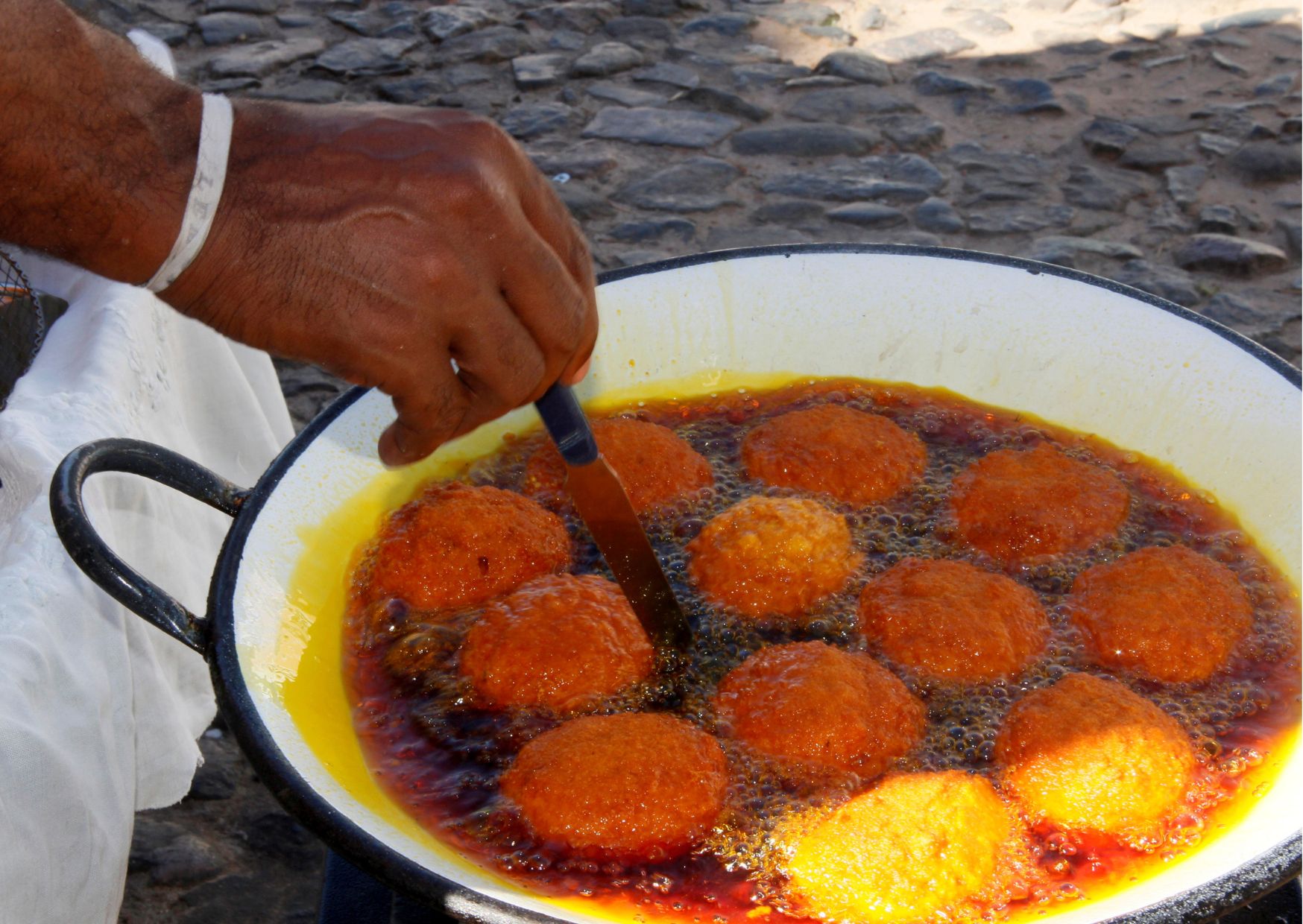
‘Acarajé’, one of the staples of Afro-Brazilian cuisine, is very common in the Bahia state. Is a type of fritter made from cowpeas or beans (black eye peas) originally from Nigeria, Togo and Benin.
If you were to speak about the link between Portugal and the African continent with the average Portuguese folk today, chances are their mind would immediately come up with images related with the days of colonialism or, at the most, when the Portuguese started setting up trading ports in strategic locations of the African coast, which would serve as base points on their trips back and forth to India and the rest of Asia – we have explored this topic with more detail here!
But Africa has managed to influence Portugal and the way the Portuguese perceive food much before that! If we don’t go as far back as to analyze that, ultimately, all modern humans do come from Africa, we could in more recent times point out at least four different moments in history which were central for the link between Portugal and Africa:
- In the 8th century, when the Moors from northern Africa took over the Iberian Peninsula;
- In the 1400s, when the Portuguese conquered Ceuta, in north Africa, and shortly after carried on their maritime voyages to India, circumnavigating the entire coast of Africa;
- From the 15h century onwards, when the Portuguese intensified their colonizing efforts in Africa and eventually went on to have 5 Portuguese overseas territories, which were considered colonies of Portugal.
- The presence of African and African-descent individuals in Portugal connected with the process of decolonization, which started around the 19060s but mostly materialized around the year of 1975 and presently, globalization.
We shall explore these different periods with further detail below, namely from the perspective of how the exchange that happened during those times influenced our cuisine, but it’s also important to mention how African cuisines have influences in several parts of the world, thanks to the activity of the Portuguese. The most notable example of this is the African influence on Brazilian food (giving raise to Afro-Brazilian cuisine – think of dishes with okra, palm oil, coconut milk and seafood, for example), which is a direct result of the transatlantic slave trade during which the Portuguese captured millions of African people and brought them over to Brazil, to work there while this south American country was a Portuguese colony.
Moorish influence on the Iberian Peninsula (8th century onwards)

‘Cataplana’, very common in the Algarve region.
When we think about the link between Portugal and Africa, the period when the Portuguese started the Era of Explorations (and exploitation), circumnavigating the coast of Africa onwards to Asia (15th century), often comes to mind. In reality, the connection between Portugal and different cultures coming out of Africa originated many centuries prior to that, way before the Portuguese could even phantom that they’d “control” half the world.
In the early 700s, the Moors from Northern Africa came to the Iberian Peninsula. The Gibraltar Strait, which only sees Europe and Africa divided with about 50 Km of sea in between, represented a small distance geographically speaking, but a big cultural gap which with this human movement was about to significantly shrink.
While technically not an ethnicity or well defined cultural group, the Moors were the Muslim inhabitants of the Maghreb region. These North African Berbers with Arab origins were the first Africans to have a real impact in the culture not only of Portugal, but the majority of the Iberian Peninsula (that is, also Spain), leaving a mark particularly in some of the foods we still eat today (but also on Portuguese language, architecture and arts, for example).
When you look into the repertoire of traditional Portuguese cuisine, the northern African influences are tremendous. After all, the Moors from Northern Africa settled in Portugal between the years of 712 and 1249, quite a considerable amount of time! The more straightforward influence the Moors had on our eating habits was the introduction of new ingredients which meanwhile gained prominence in our country. We can think of foods which are now very associated with the Algarve, such as almonds, figs, oranges and other citrus fruits, coriander, cucumber, cumin, apricots, carob, vermicelli noodles, and more.
New food preservation and cooking techniques were also introduced and eventually became so common that they are now perceived as part of traditional Portuguese food habits. From the way of drying octopus and tuna (muxama) in the Algarve, to breading and deep-frying fish, to steaming a variety of proteins and vegetables inside a closed clamshell looking vessel known as cataplana, the examples of Moorish influence in traditional Portuguese cooking are numerous.
Portuguese dishes with Arab and Berber influence
Traditional Portuguese foods which are a clear inheritance of North African cuisine include:
- cataplana: seafood and/or meats cooked with vegetables inside of a clamshell cooking vessel by the same name, which easily resembles a Moroccan tagine, and which steams the ingredients locked inside during the process;
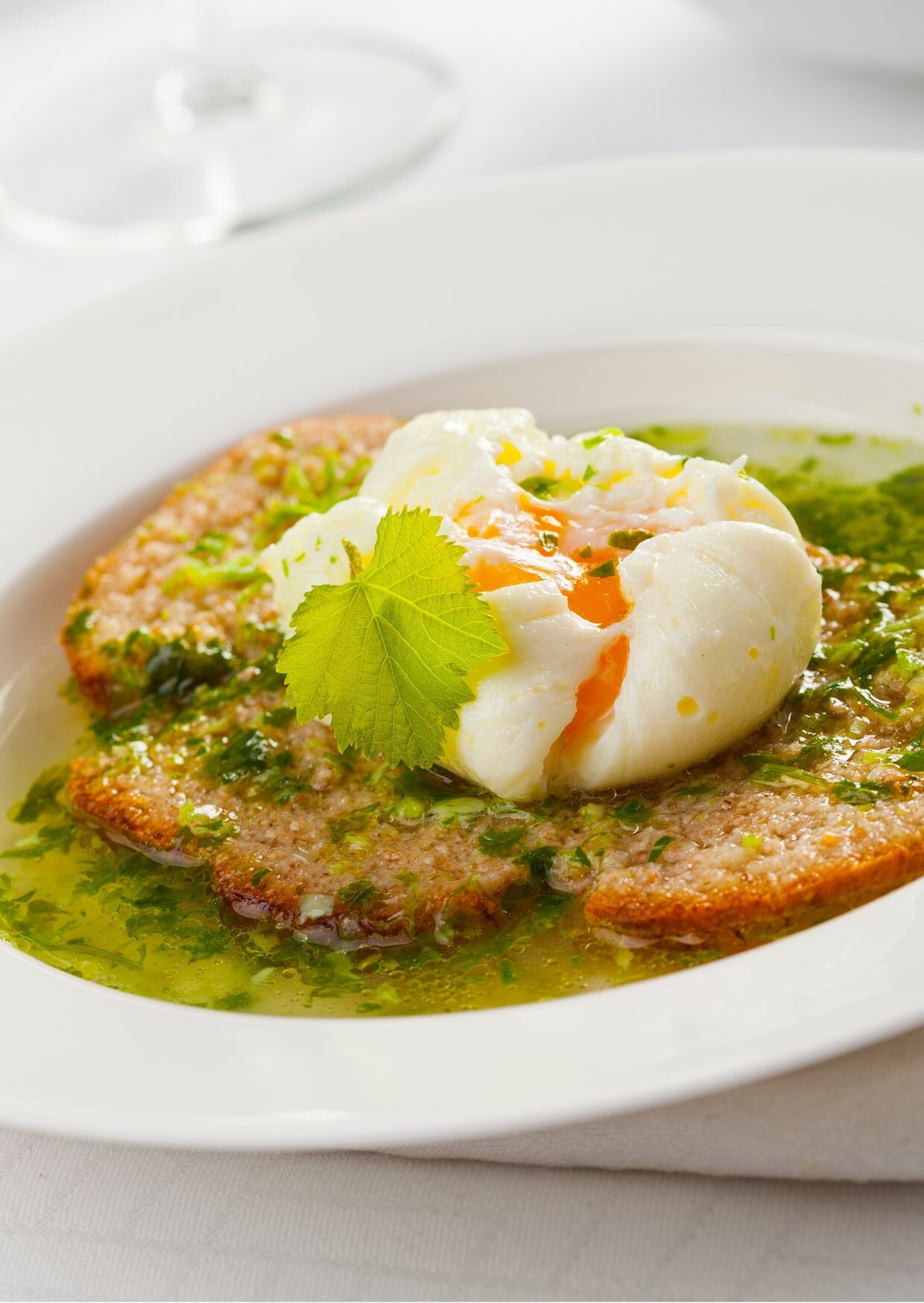
‘Açorda’, is a dish with Arabic origins, whose name derives from ‘al-thurda’.
- escabeche: vinegary marinade applied mostly to seafood, now used as a way to develop flavors but back then also as an important preservation method to extend the shelflife of fresh ingredients;
- couscous: even though not many would associate couscous with Portugal, in the northern inland Portuguese region of Trás-os-Montes, wheat cuscos were for centuries hand-made and eaten with meats and vegetables, a tradition mostly carried on by the Jews of the region which is now being revived by Portuguese chefs keen on bringing tradition to contemporary times, often times with new interpretations;
- migas: savory pan-fried pudding made with leftover bread;
- açorda: slices of bread served with garlic and coriander flavored stock poured over, and topped with poached fish and/or egg;
- aletria: creamy angel hair pudding, now-a-days traditionally dusted with ground cinnamon;
- filhós: leaved dough fritters, similar to flatter doughnuts;
- sweets with nuts and dried fruits, such as those we find in the Alentejo and Algarve regions, including alconomias, figos cheios, queijinhos de amêndoa or doces finos, aka marzipan.
These are all foods which were introduced into the Iberian Peninsula by the Moors from northern Africa who were, in their turn, influenced by Arabic peoples from other regions of not only northern Africa, but also the Arabian peninsula and the broader Islamic Empire.
Even when we don’t see the obvious influence of Moorish culture directly translated into our specific recipes, we can still find a connection via the most common cooking methods we still use today. Cooking stews (such as Portuguese caldeiradas or ensopados) was popularized specially during this time, always with focus on one pot wonders meant to feed large families – in fact, the Mediterranean diet we observe in the south of Portugal, is a direct product of the Moorish presence in this region! If we dig even deeper, even the mills of the Alentejo were developed during those times and, even though the region was already known as a wheat growing part of the country since Roman days, this is when the production of the cereal and breads prepared with it became bigger, thanks to new technology developed by the Moors.
Whether it was by the introduction of new ingredients, cooking techniques, new recipes, or even food growing methods (including irrigation and other techniques which forever changed the agricultural landscape of Portugal), there’s no denying of how big the Moorish culinary contribution was to the way the Portuguese were eating and are still eating today!
Portuguese maritime explorations and the first contact with Northern Africa (1415)
When we speak of the Portuguese presence in the African continent, we might immediately think of the countries which were colonized by Portugal: Angola, Mozambique, Guinea-Bissau, Cape Verde and São Tomé e Príncipe. But, way before any of these countries were even on the radar for Portuguese navigators, the Portuguese were already keen on exploring (and exploiting) other parts of Africa, namely the north of the continent. Naturally, geographically speaking, this was the closest region to the Iberian Peninsula, thus it made sense to start here.
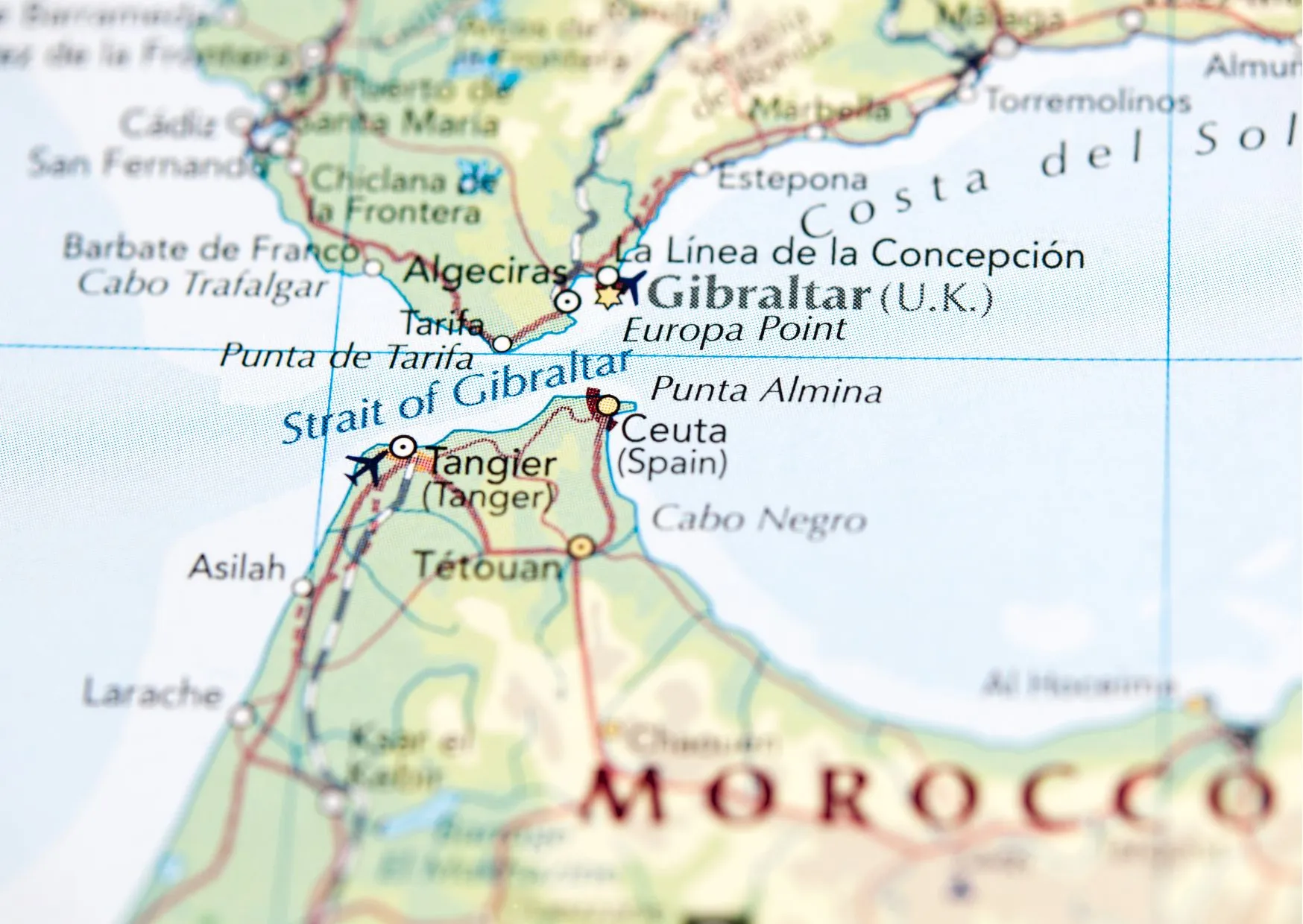 At the beginning of the 15th century, Portugal found itself in a relatively undeveloped and unproductive phase. This, more than the adventurous spirit we often coin for this period of Portuguese history, was the motive behind going out to sea and exploring new parts of the world. With the purpose of finding new resources and sources of wealth, the Portuguese reached India, ventured further east to Macau (today a part of China), Malacca (in Malaysia) and Japan, made it to Brazil on an unexpected detour but, before all that, sailed to the north of Africa.
At the beginning of the 15th century, Portugal found itself in a relatively undeveloped and unproductive phase. This, more than the adventurous spirit we often coin for this period of Portuguese history, was the motive behind going out to sea and exploring new parts of the world. With the purpose of finding new resources and sources of wealth, the Portuguese reached India, ventured further east to Macau (today a part of China), Malacca (in Malaysia) and Japan, made it to Brazil on an unexpected detour but, before all that, sailed to the north of Africa.
During the reign of D. João I, a Portuguese fleet sailed to Ceuta (which is now-a-days a Spanish autonomous city on the north coast of Africa), and conquered the territory which would inaugurate the Portuguese intrusion in the African continent. This changed Ceuta but it also certainly changed Lisbon and, little by little, the rest of Portugal. During the early years of having Ceuta under Portuguese command, the city life of Lisbon (which was already quite multiethnic and multicultural since the Moorish occupation), saw itself bursting with activity, particularly by the waterfront. Trade increased and so did the number of people coming to the city.
During this period there weren’t lots of new ingredients introduced to Portugal, as foods from these regions would have already been brought over centuries before when the Moors took over parts of the Iberian Peninsula. But that doesn’t mean there weren’t changes in the way we eat because of this movement of the Portuguese to Africa. There’s one particular dish from the north of Portugal, tripas à moda do Porto (Porto style tripe stew) which is believed to be associated with this period of Portuguese history. Even though there are several theories which support and contradict this hypothesis, one of them explains that this humble (yet very tasty) stew with beans, tripe and other tidbits of meat came about during a time when the primest cuts of meat were reserved to be sent aboard the boats which were used for the maritime explorations (which first took the Portuguese to Ceuta and then eventually down the coast of Africa, around South Africa’s Cape of Good Hope, and onwards to India and the rest of Asia). One thing is for sure: during these long trips which would take months, the Portuguese tradition of salt curing fish sure was used as a way to guarantee that food would be available for the crew, no matter if they’d be able to come across more ingredients during the trip or not.
Portuguese colonization in Africa (16th – 20th centuries)
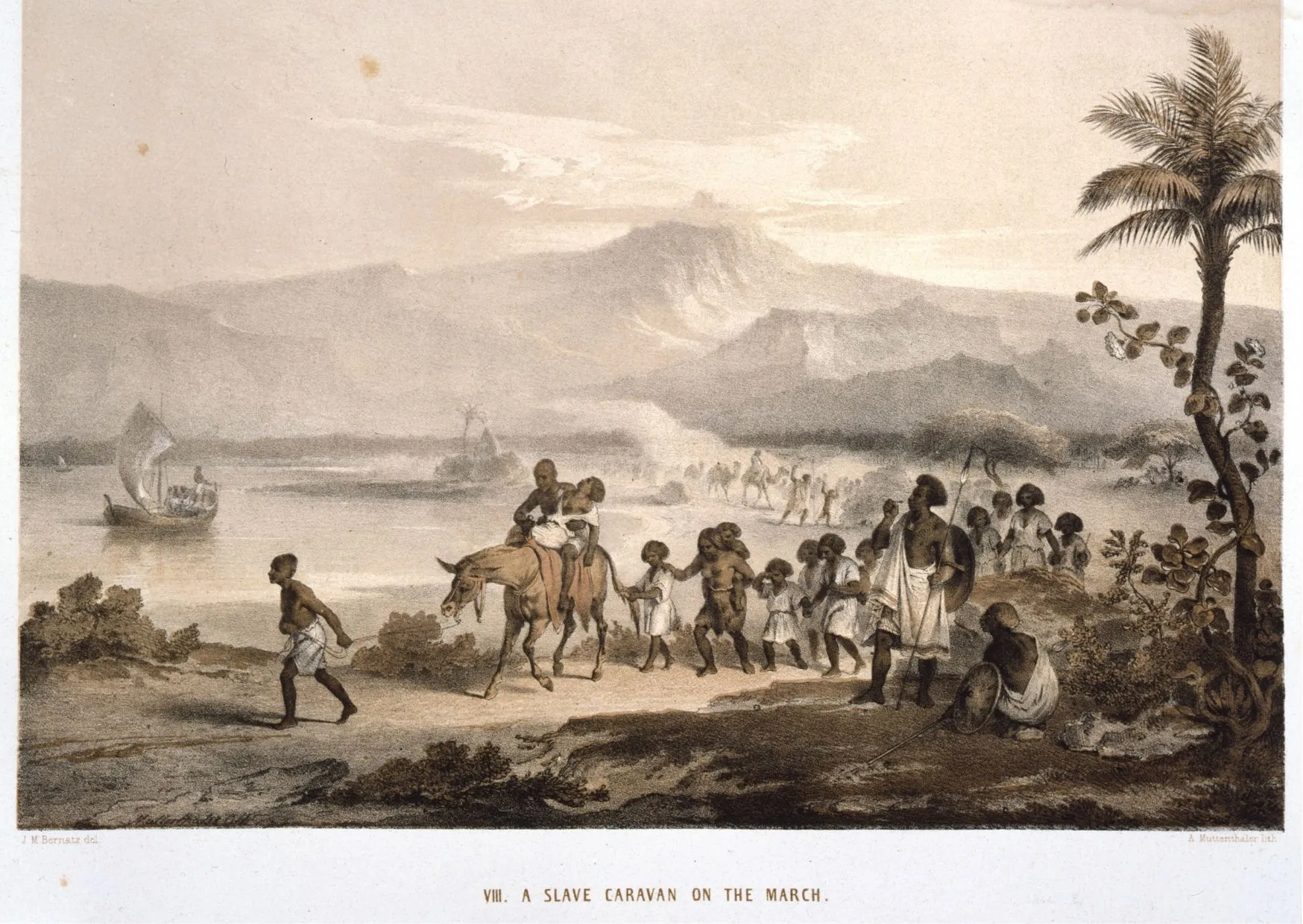 The colonization of different African territories by the Portuguese would have probably never come about if it wasn’t for the keen interest the Portuguese had on the spices coming from the Indian subcontinent. Until this moment, spices were brought over to Europe by land, in a trade dominated by the Arabs. Passing by different countries would mean taxes would pile up on the price of goods, and thus spices would reach western Europe at a very steep cost. The Portuguese were keen on bypassing this and having direct access to the source, and so inspired by this economic interest and supported by their advanced sailing devices and techniques, they headed to India.
The colonization of different African territories by the Portuguese would have probably never come about if it wasn’t for the keen interest the Portuguese had on the spices coming from the Indian subcontinent. Until this moment, spices were brought over to Europe by land, in a trade dominated by the Arabs. Passing by different countries would mean taxes would pile up on the price of goods, and thus spices would reach western Europe at a very steep cost. The Portuguese were keen on bypassing this and having direct access to the source, and so inspired by this economic interest and supported by their advanced sailing devices and techniques, they headed to India.
Navigating down the western coast of Africa, around South Africa and eventually upwards the eastern coast of the continent, the Portuguese started establishing trading ports, which were used to stock up locally and, most of all, to transport goods from different points of Africa onwards to Asia and back to Portugal. At this time, there was already ongoing trade between Africans and Indians, sometimes happening directly and, at other times, carried out by Arab ships operating in the areas bathed by the Indian ocean. Infiltrating the commerce which was taking place in western Africa initially proved more challenging that becoming a part of the trade which was happening in the eastern coast, where the Portuguese didn’t shy away from destroying established trading points in coastal cities, in order to impose their own presence and carry their own trade in a way which would be more beneficial to their power and wealth hungry goals.
The first Portuguese territories in Africa came about in the shape of prazos, which were massive pieces of land given by African rulers to the Portuguese, in exchange for a fixed annual fee. These were lands worked on by locals (colonos) in a semi-feudal system (mimicking something previously done in Europe), 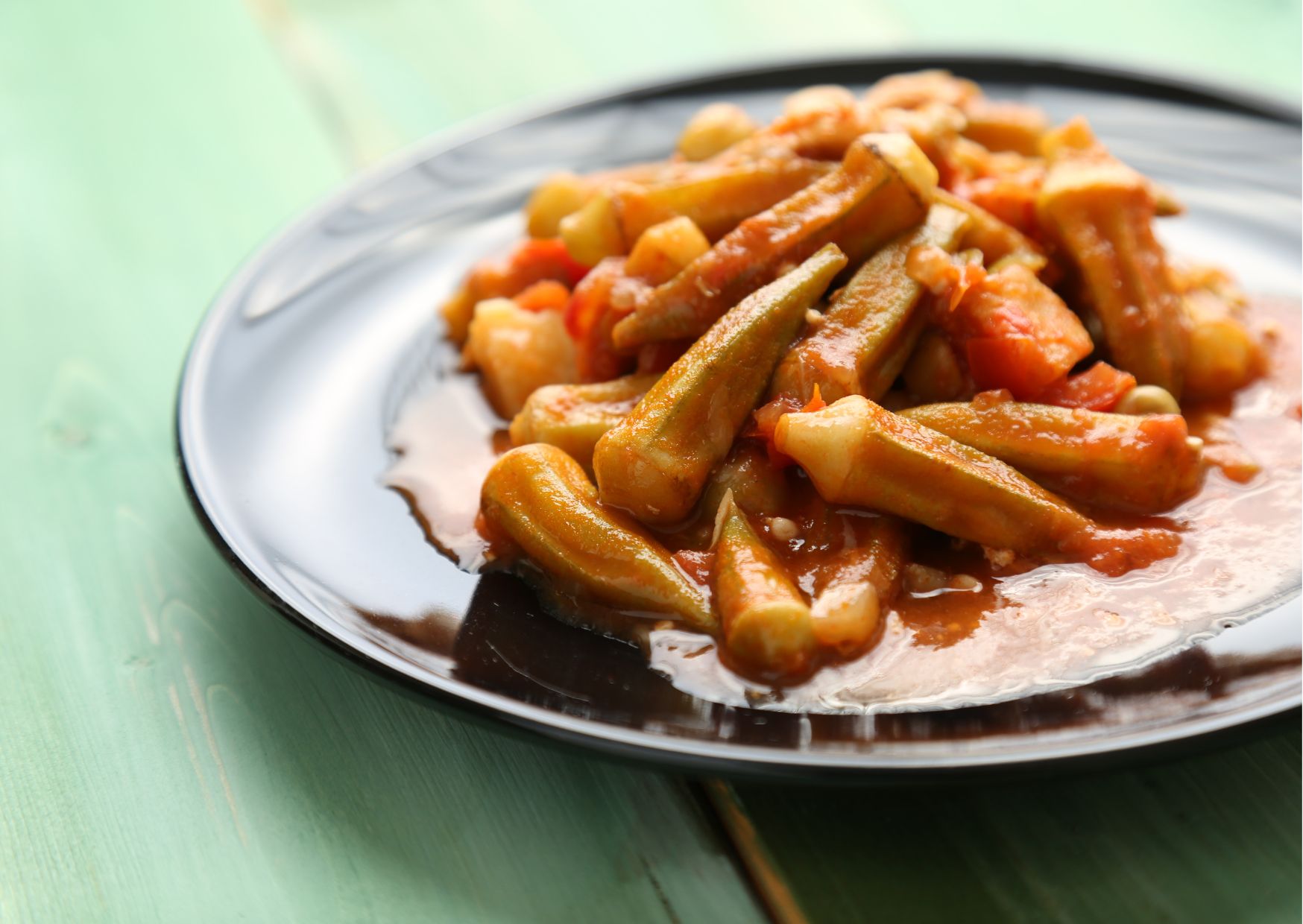 which were the pillars for the more complex colonization of African countries by the Portuguese that ended up happening later. Prazos were worked on extremely unfair conditions, which saw the Portuguese settlers accumulate wealth thanks to the hard work of local African farmers and, afterwards, even slaves (originally social outcasts which the Portuguese were very comfortable taking advantage of). Colons easily went from using the work of slaves to entirely colonizing an entire country, with no remorse, as if this was a granted indisputable right.
which were the pillars for the more complex colonization of African countries by the Portuguese that ended up happening later. Prazos were worked on extremely unfair conditions, which saw the Portuguese settlers accumulate wealth thanks to the hard work of local African farmers and, afterwards, even slaves (originally social outcasts which the Portuguese were very comfortable taking advantage of). Colons easily went from using the work of slaves to entirely colonizing an entire country, with no remorse, as if this was a granted indisputable right.
Even though the Portuguese had a presence in Africa during centuries via their trading ports, and certainly did exploit this during tumultuous centuries of slave trade from Africa to (mostly) the Americas, the efforts to expand this presence with proper colonies in the continent surfaced in the 19th century, when Portugal had already lost its (formerly very lucrative) colony of Brazil. At the time, other European powers such as France and Britain already had big colonies in Africa, and Portugal didn’t want to be left behind. This was when the Portuguese started taking over more land in Angola and Mozambique, and eventually also the countries which we know today as Cape Verde, Guinea-Bissau and São Tomé and Príncipe.
The Portuguese diaspora in Africa had major influences in the way we eat in Portugal today, not only because of access to new ingredients, but mostly because of the trade which was now being done between The New World (that is, the Americas), Europe and Asia, and which would always had to come via African ports. This was also when ingredients of African origin started being consumed the most by the Portuguese, some of them living on to be incorporated in Portugal’s day to day cooking.
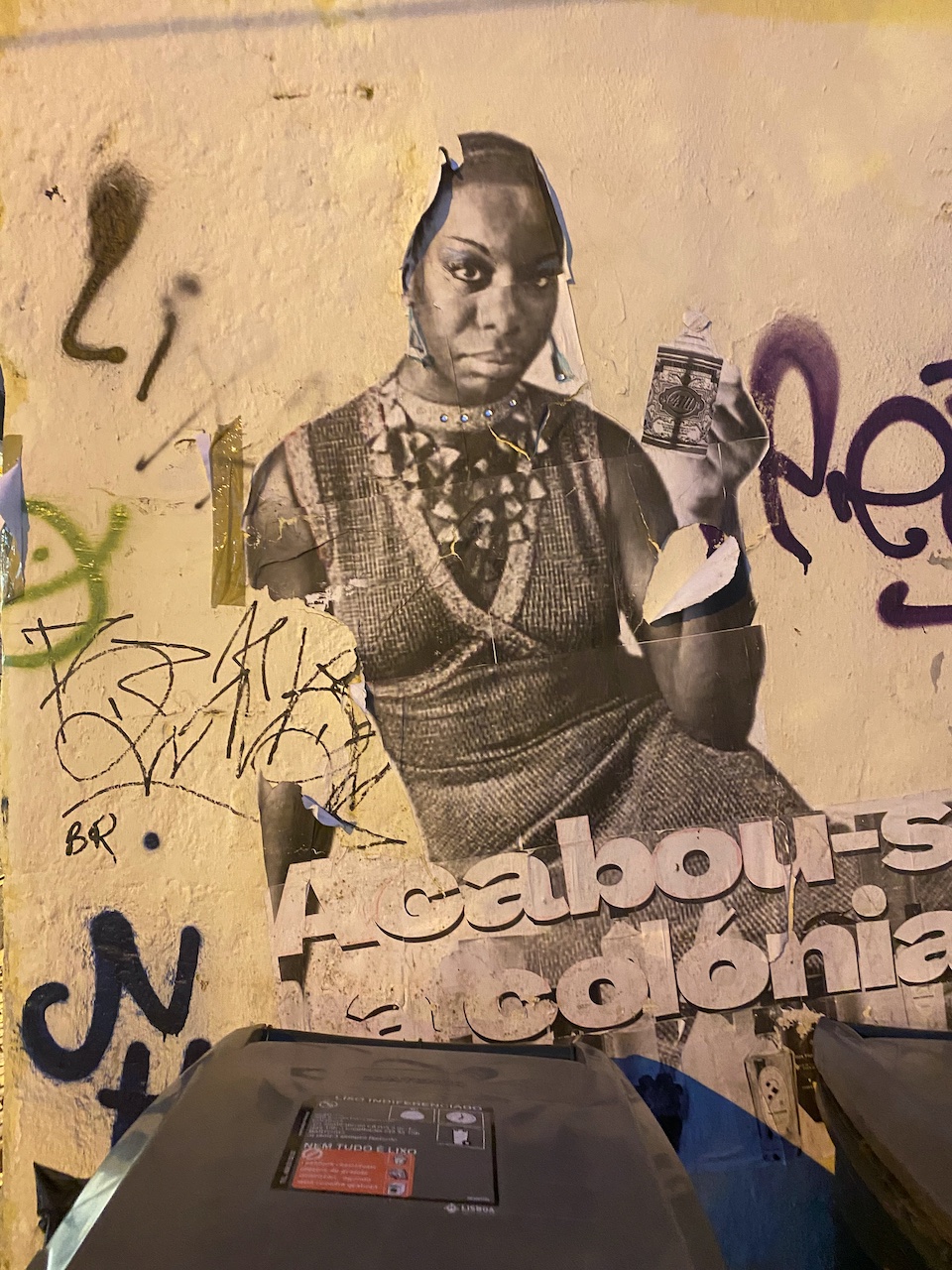
Smart and provocative street art in the Graça district (Lisbon). You can read, in Portuguese, ‘the colony/cologne is over’ (‘Acabou-se a colónia’) when Nina Simone has a bottle of cologne in her hands. The Portuguese word for colony and cologne is the same: ‘colónia’ (© Silvia Olivença)
Some of the most common ingredients having originated in Africa and now consumed in Portugal and worldwide, include: coffee, peanuts, okra, palm oil, yams and watermelon, to name a few. But we have got to admit that Africa’s botanical legacy was the most evident in the Atlantic world, even if it was because of European trade.
African diaspora in Portugal
The presence of African and African-descent individuals in Portugal is intrinsically connected with the process of decolonization, which started around the 19060s but mostly materialized around the year of 1975. This process was a direct consequence of the democratization of Portugal, after the revolution which took place on the 25th of April of 1974, which ended the dictatorship and inaugurated the democratic system in Portugal. As Portugal’s colonies in Africa gained independence, the exodus of Portuguese colonial settlers ensued, thus increasing the African influences brought over to Europe. This was also when The Community of Portuguese Speaking Countries (CPLP) was formed and, until today, this is a group of countries which are culturally connected and which are often most associated when we think about the connection between Portugal and the several African nations.
After Angola, Mozambique, Cape Verde, Guinea-Bissau and São Tomé and Príncipe gained independence from Portugal, not only could we observe an exodus of Portuguese settlers and their descendants (particularly those of mixed race) coming back to the old continent, there was also a brand new migration. This new human movement consisted of African people coming to Portugal, particularly in the 80s when the country seemed to offer decent economic opportunities, and who settled in and around Lisbon, and to a certain extent the Algarve region too, thus giving origin to the Afro-Portuguese population we have in the country today.
Contrary to other countries, Portugal doesn’t do statistics based on ethnicity or race (something that is often linked to Portugal not being a racist country, but that it’s highly debatable based on the actual reality), so actual numbers of black Portuguese of African descendancy are hard to pinpoint. In any case, even when you’re dealing with an African descent person in Portugal, you shouldn’t assume they are indeed African, as in the vast majority of cases, considering the following generations born and raised in Portugal, we’re talking about full fledged Portuguese citizens.

Traditional ‘cuscuz’ corn cake, steam cooked in a ‘binder’, a Cape Verdean special recipient made of clay (© Silvia Olivença).
Dishes which have originated from the Portuguese-African connection
As we have explored above, the first foods which have originated from the African-Portuguese connection are those that came about during the Moorish occupation of the Iberian Peninsula. After the first king of Portugal, D. Afonso Henriques, took Lisbon back from the Moors in 1147, christianity became the new imposed faith in the country and the Moors, which were muslim, were either pushed back to the south of Portugal (and eventually to the north of Africa) or forced to live in ghetto areas of Lisbon, such as Mouraria (whose names translates as “the place of the Moors”). Interestly enough, today, Mouraria is still one of the most diverse neighborhoods of Lisbon, where African descent communities cohabit with folks from the Indian subcontinent, Chinese, other Asians, East Europeans, and immigrants a little from all over the world, counting about 50 different nationalities in this neighborhood alone!
Mouraria and surrounding areas are also one of the best places in Lisbon to eat both authentic African foods, particularly from Portugal’s ex-colonies but not limited to them, as well as food which came about from the Portuguese-African connection. We could speak about African influenced Portuguese food, as well as Portuguese influenced African cuisines. And even Afro-Brazilian food which was brought over to Portugal by Brazilian immigrants who, centuries prior, saw their eating habits also impacted by the influence of Portuguese colonizers, who were are the origin of the popularization of Portuguese-Brazilian foods (such as Brazilian feijoada which originated in Trás-os-Montes, in Portugal, but gained its south American characteristics thanks to the taste preferences of African slaves inhabiting in Brazil, who used to eat such filling stews with beans and pieces of meat as a cheap source of energy to fuel their hard labor in plantations). Ingredients, knowledge and traditions have blended and keep blending, thanks to the exchange between peoples and cultures.
When we look into how native African cuisine has influenced Portuguese food, it’s hard to highlight specific dishes, as this is a product of over 500 years of social, economic and culinary interaction between the peoples of Portugal and those from different parts of Africa. Still, some examples of this culinary exchange include curry, particularly chicken curry, which is a Creole Afro-Lusitanian food, clearly also influenced by the Indian presence in the former Portuguese colonies in Africa, namely in Mozambique. In fact there are several types of curry which you can taste in Portuguese restaurants today, and African restaurants across Lisbon too, which were brought over to Portugal from Africa (even if at their inception they incorporated Indian origins too).
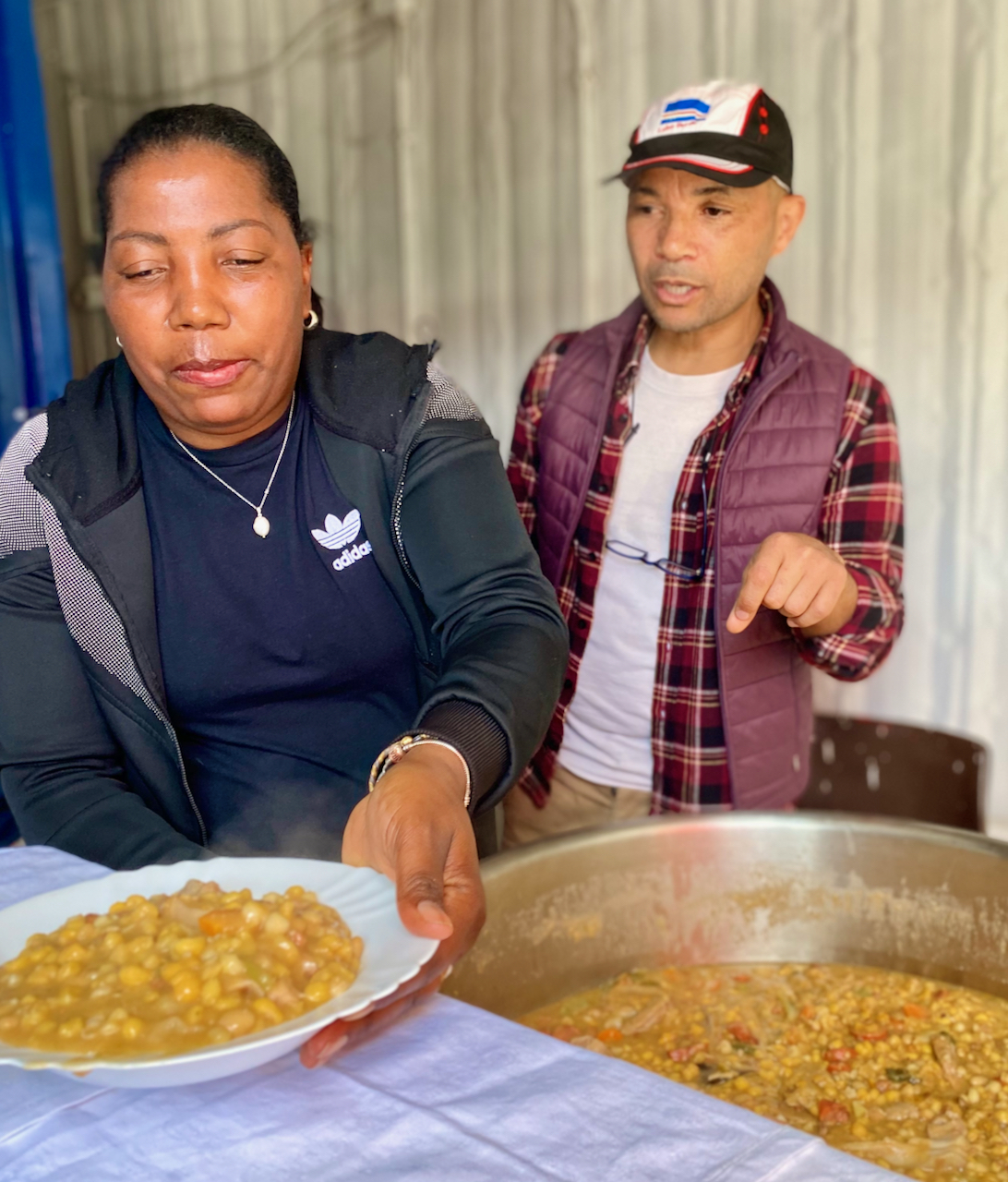
Cape Verdean ‘cachupa’ (© Silvia Olivença)
Samosas, or chamuças as they’re known in Portugal, are another clear example of African influence in Portuguese food. You will find these fritters in many Portuguese cafés, alongside cod fritters and meat croquetes. Once again, this is a Mozambican (or, more broadly but truthfully speaking, West African cuisine) influence in Portuguese eating habits, which in its own turn results from the Indian influence in Mozambican territory, very much facilitated by the Portuguese trade (but not only existent because of it). In Portugal, unlike in most parts of India where vegetarian samosas are the staple, chamuças are usually stuffed with curried chicken or minced meat, in this case an inheritance of Goan cuisine in Portugal.
There are a few other dishes which are distinctly African but which we now-a-days regularly eat in Portugal, and even though we don’t (and shouldn’t!) perceive them as Portuguese, they often make it to the menus of restaurants serving typical Portuguese foods, if not all over the country, at least in multicultural Lisbon. We’re talking mostly about cachupa, a stew of west African cuisine with beans, cassava, sweet potato, and proteins such as fish or meat; and moamba, a very popular dish from central Africa, with spiced chicken cooked to a stew consistency in abundant palm oil.
South-African or Portuguese? The curious case of the popular peri-peri chicken
The Portuguese diaspora is still evident today in certain parts of Africa, namely in the ex-colonies, as well as neighboring countries. When Mozambique gained independence from Portugal in 1975, South Africa received a significant number of Portuguese folks who decided to stay in the African continent, rather than returning to Europe. Today, Portuguese descent folks makeup about 0.5% of the South-African population. This brings us to the rise of the so-called “Portuguese peri-peri chicken” and how, even though it originated in South Africa, it is internationally associated with Portugal.
Grilled chicken was a common food prepared by the Portuguese in South Africa. In fact, it was already being prepared in Mozambique by folks from the same origins. What distinguishes this grilled chicken from most is the marinade prepared with fiery chili peppers (in the form of piri-piri sauce), which were brought over by the Portuguese from The New World across the Atlantic, and quickly gained a following throughout Africa. Today, it would be hard to picture some of Africa’s cuisines, namely South African, without the heat induced by peri-peri or piri-piri (Swahili for “pepper pepper”), which is a cultivar of the malagueta pepper.

Peri-Peri Chicken
International restaurant chain Nando’s can be largely credited for the popularization of peri-peri chicken all over the world. This successful business was founded by a South African and Portuguese descent South African duo, which uses a lot of Portuguese elements on their branding, including the Barcelos cock, often seen as the symbol of Portugal in our country and, increasingly, abroad. No wonder the world thinks peri-peri chicken is a Portuguese dish when, in reality, it is a food which originated from the Portuguese-African relation and was brought to Portugal with the return of Portuguese colonizers and their descendants when they came back to Europe (retornados), as well as with the African diaspora from the ex-colonies.
Peri-peri chicken has several of the tastes which we can associate with South African cuisine, the cuisine in Portugal and, above all, the blend of both (Afro-Lusitanian cuisine): heat from the chilies, acidity deriving from vinegar, and flavor intensity from using garlic.
When you order grilled chicken (frango de churrasco) in Portugal today, don’t expect it to be like the peri-peri chicken Nando’s and other subsequent restaurants have popularized worldwide. Here in Portugal, chicken is spat scotched and grilled over charcoal but only after it’s grilled is it brushed with peri-peri sauce (upon request), instead of being marinated with it to begin with. Alternatively, you may not even get peri-peri chicken as such, but be served succulent grilled chicken and a bottle of peri-peri sauce which would be placed on the table to add to your dish to taste. In fact, you can always order peri-peri sauce (molho piri-piri) in any given Portuguese restaurant, knowing that sometimes it’ll be home-made and other times store-bought, and add it to other foods rather than meat. We think it works particularly well with certain types of seafood (like sautéed prawns with olive oil and garlic, aka, gambas à guilho), and saucy rice dishes such as seafood rice (arroz de marisco) or kidney beans rice (arroz de feijão), and so do many other Portuguese folks who tend to like spicing up their Portuguese typical food.
Where to taste African influenced food in Lisbon
The dialogue that Portugal and several African nations (which is certainly not limited to previous colonies, even if it’s mostly been molded by them) often translates into food related forms of expression. Dishes, the use of specific regional ingredients, collaborations between different chefs, events and more.
For instance, the Congresso dos Cozinheiros, which is an yearly gastronomic event happening in the Great Lisbon area dedicated to professionals of the hospitality world (but also open to anyone curious), had its 2022 edition dedicated to “the African connection”. During two days participants had the chance to attend talks and cooking demonstrations by some of Africa’s most renowned names in the food world. The idea was not only to bring African foods a little closer to the Portuguese reality, but to encourage debate and eventually bring down barriers which often come up thanks to lack of knowledge. As the organizers of this chefs’ congress put it “food is an activator of culture, a form of civilizational evolution, and a powerful tool to touch people”. This kind of event is relevant not only to promote a healthy (and delicious!) exchange of ideas, but also to further value African cuisine and chefs who may be in Portugal often associated with ex Portuguese colonies in Africa, thus being a little “stuck in time”. It’s important to note that African food goes way beyond what the Portuguese might have come to know because of their direct connection with previous colonies but, also, that it keeps on making an evolution and still has the potential to keep influencing the way we cook and eat in Portugal today.

Congresso dos Cozinheiros – African Connections, 2022 editions. In the picture Chef João Carlos Silva (from São Tomé Príncipe) and the congress organizers, Paulo Amado and Mestre André (Chef) (© Sílvia Olivença)
Manja is a recent project which has been attracting our attention lately. This culinary initiative by Edições do Gosto, which publishes about food in Portugal and even organizes awards to highlight some of the country’s best chefs and establishments, wants to contribute to making African cuisines more well-known in Lisbon. Ultimately, as organizer and gastronome Paulo Amado puts it, “it’s about promoting diversity and sharing”. Once a month, cooks from different backgrounds come together to prepare a meal and to ‘discuss interculturality and the lack of representation that we have at the table”, oftentimes, without us even realizing it. Hernâni Miguel, owner of restaurant Tabernáculo (Rua de S. Paulo 218) in downtown Lisbon, is also involved in Manja’s sessions, stressing how initiatives such as these are important to break down barriers, for the sake of representation, and to promote the cuisines of Africa, but, most of all, of Euro-africans! Talking about food is talking about identity, even if it’s a fluid identity.
Lisbon’s food scene is strongly influenced by the cuisines of Portugal’s former colonies in Africa. You can go to excellent Mozambican restaurants (like Cantinho do Aziz, Rua de São Lourenço 5, or Roda Viva, Beco do Mexias 11 R/c), sample Angolan stews (for example at Casa de Angola, Travessa da Fábrica das Sedas 7), or pan-African foods (Criolense Kitchen Club, Rua Damasceno Monteiro 12, is a must for food and ambiance!). The cuisine from Cape Verde is also very well represented in Lisbon, with many restaurants to choose from, often mixing traditional Cape Verdean and typical Portuguese dishes (for a great intro to Cape Verdean food in Lisbon, visit Associação Caboverdeana, Rua Duque de Palmela 2 – 8th floor, or Tambarina, Rua do Poço dos Negros 94).
Besides eateries, you can easily purchase African origin ingredients in Lisbon, both at stores (such as Loja Africana inside Mercado da Ribeira, Av. 24 de Julho 49; Mercearia Pérola do Arsenal, Rua do Arsenal 94; or the many African ingredients specialized stalls inside Benfica’s municipal market, Rua João Frederico Ludovice 354) or even at informal road-side street markets such as those you’ll find around Largo São Domingos, near Rossio. Of course, piri-piri sauce can be purchased in just about any Portuguese supermarket – if you like it extra spicy, look for the word sacana (Portuguese for bastard) in the package!

Mestre André is our favorite Portuguese Chef. Not to say, world’s favorite! (© Silvia Olivença)
If you’re also curious to try Moorish influenced Portuguese foods in Lisbon, we’d recommend visiting an Alentejo focused restaurant, like Solar dos Nunes (Rua dos Lusíadas 68), O Magano (Rua Tomás da Anunciação 52A), or Salsa & Coentros (Rua Cel. Marques Leitão 12). To taste other dishes such as those associated with the Algarve region in the further south region of Portugal, head to Taberna Albricoque (Rua Caminhos de Ferro nº98), where the Moorish influenced Mediterranean cuisine of the Algarve dominates the menu. You could also visit Vamos ao Algarve (Rua do Terreiro do Trigo 88) for a slice of orange and carob cake, something that wouldn’t probably exist without the north African influence in the Algarve. To sample a steamy cataplana, a dish often served in traditional Portuguese food restaurants, such as those specializing in seafood, we recommend Aqui Há Peixe (Rua Trindade 18A), headed by Chef Miguel, who’s a cook and, funnily enough, also the boat captain during our Lisbon Boat Tour with a Chef Onboard!
As we’ve said before, Lisbon is one of the best places in Europe to eat a variety of African cuisines. But African influences in Portuguese cuisine and overall Lisbon’s dining scene aren’t limited to examples of long running traditions. There’s a new wave of chefs who are making it a point to incorporate elements of African cuisines (particularly those of Lusophone countries) into their creative signature dishes, which are expressions of a more globalized world and interwoven food habits. To try this contemporary vein of African influenced Portuguese cuisine, we recommend visiting restaurants such as Michelin starred Feitoria (Altis Belém Hotel & Spa, Doca do Bom Sucesso), where the traditional Portuguese kitchen opens its doors to other cuisines of the world, namely Africa; or A Taberna da Rua das Flores (Rua das Flores 103), where chef André Magalhaes, aka Mestre André, crafts an innovative menu which also has Portuguese cuisine on its foundation, but doesn’t shy away from African (and other) elements – try their version of chicken moamba to understand what we’re talking about!
How African cuisines keep influencing Portuguese eating habits thanks to globalization
Now-a-days, African cuisines keep on having an impact on the way the Portuguese cook and, even more so, when they go out to eat, particularly in bigger cities like Lisbon. Thanks to globalization, the world is more connected than ever. And, even from a distance, thanks to the power of communication and particularly of the internet, it’s possible to exchange ideas even without having physical contact. Thanks to the potential that new ways of communication have to shorten geographical distances, brand new cultural expressions materialize, either deepening previous cultural influences or even branching off into various ways.
We feel that Lisbon is like no other European capital. Sometimes, a tad more African than stereotypically European, the biggest city of Portugal is at a crossroads between the old continent and Africa. There is a very distinct African vibe as you walk Lisbon’s streets, particularly around Rossio, Martim Moniz and Mouraria.
Today, in Lisbon, not only you’ll come across African inspired Portuguese foods, and restaurants from different African nationalities, but also foods which are fundamentally connected with Africa, even if they didn’t come directly from this continent. We’re talking, for example, about soul food traditionally prepared by African-Americans, which is now starting to be featured in some of Lisbon’s restaurants (North American or with more globally inspired menus), not thanks to the historical direct link between Portugal and Africa, but because of American influence in our country. This is a beautiful example which comes to show how food and habits from a certain ascendency can travel around the world, gaining new shapes and incorporating new ingredients and/or techniques according to local communities and external factors, keep on being exported internationally and, ultimately, never settle to be one thing and one thing only.
Food is ever evolving and, as the global palate keeps broadening its horizons, we’re happy to see how individuals and communities are increasingly more open to “foreign” ingredients, cuisines and eating habits – ultimately, this is contributing to bringing us all closer together. Because, at the end of the day, we may have our own characteristics and peculiarities, but we all come from the same place: Africa!
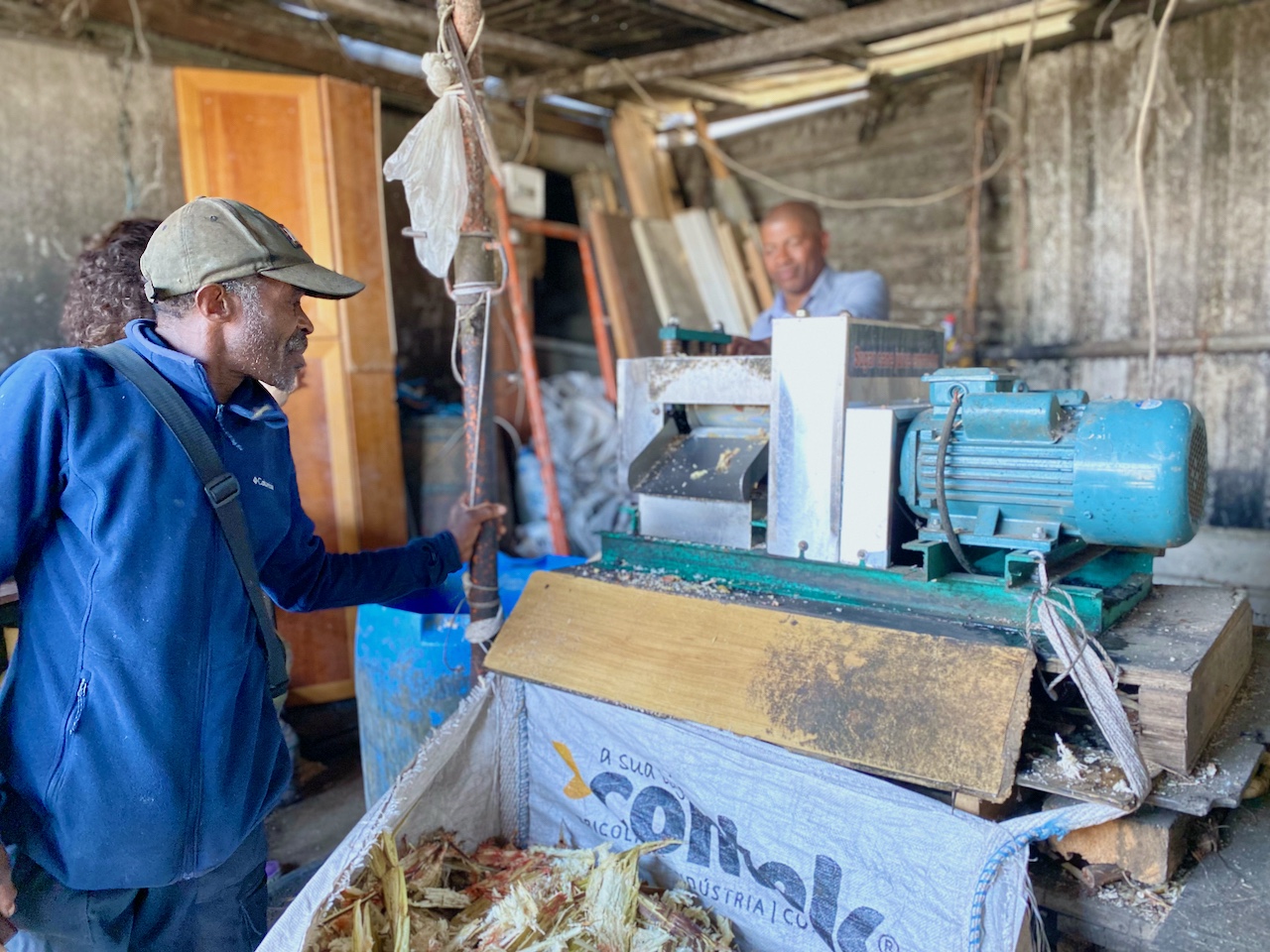
Sugar cane machine to extract sugar cane juice, in a Cap Verdean community, located on the outskirts of Lisbon (© Silvia Olivença)
Article by :
Zara Quiroga (freelance food writer and food & cultural leader at Oh! My Cod Pico Trips)
Sílvia Olivença (anthropologist and food guide/CEO at Oh! My Cod Ethnographic Food Tours & Trips)
Want to more about Portuguese cuisine and its influences?
How Portugal influenced Indian cuisine
Alentejo and Algarve: culinary traditions of the South of Portugal
10 Portuguese Codfish recipes step-by-step
Minho, Douro and Trás-os-Montes: the cuisines of Northern Portugal (includes Porto!)
